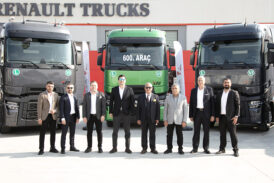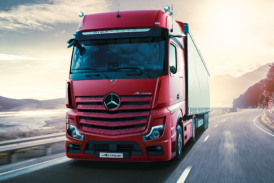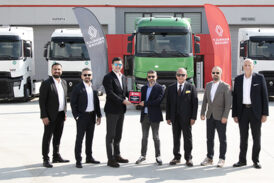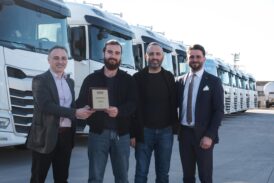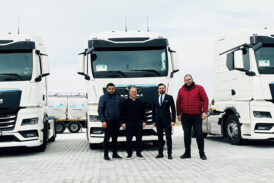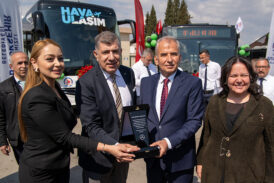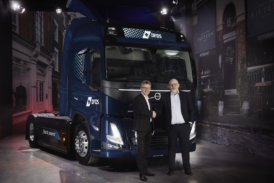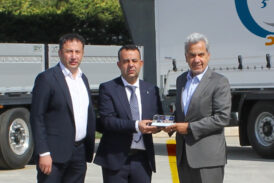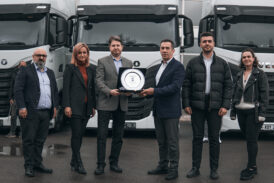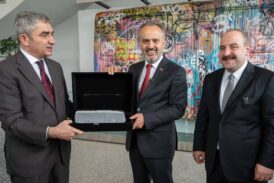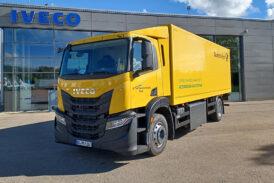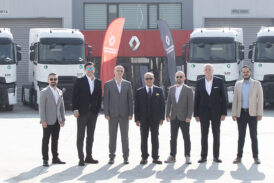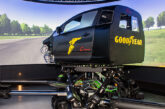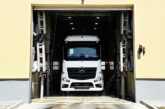Thinking around the corner
If you’ve ever sat in the cab of a 40-tonne truck, you can likely imagine how quickly it can happen: the truck driver wants to turn right at a complex intersection and fails to see a cyclist or pedestrian – and a collision occurs. The consequences of such turning accidents are unfortunately often severe or even fatal. Modern technology can help prevent these accidents or at least minimise the consequences: Since 2016, Sideguard Assist from Mercedes-Benz Trucks and other safety systems have been helping alleviate situations like this. Starting in summer 2021, Sideguard Assist will also provide automatic braking in an emergency.

Tightly scheduled trips, deadline pressure, stress, fatigue, poor weather conditions, confusing traffic situations in tight spaces and much more: truck drivers often have to cope with difficult work conditions in their day-to-day jobs. Around 13 percent of truck drivers suffer chronically from symptoms of stress. A truck’s size and mass means that a moment of inattention can have immediate, devastating consequences – for the truck drivers themselves but above all for car drivers and for especially vulnerable road users such as pedestrians, cyclists or people on electric scooters. When accidents involving trucks occur in urban traffic, these people unfortunately suffer all too often from serious or even fatal injuries.
It’s a situation nobody wants imagine: there is first of all the suffering of the victim and their loved ones. Then there are the feelings of guilt that often plague and traumatise the driver for life. And we mustn’t forget the rescue services and first responders, who also cannot simply shake off these events. If only something could be done to prevent all this!

Key component of Daimler DNA
The good news is: something can in fact be done. And we are doing it – here at Daimler, for example. The vision of accident-free driving is a key component of Daimler DNA, and this holds true not only for trucks but also for cars, vans, and buses. The company has been a leader for decades in developing safety and assistance systems, and these systems are constantly being further developed and improved. Daimler has been conducting its own accident research for more than 50 years, and since the early 1970s, Daimler’s commercial vehicle accident research has been analysing accidents involving Mercedes-Benz trucks throughout Germany in order to extract active and passive safety measures from this data. “We consider our detailed studies indispensable for assessing vehicle behaviour in an actual accident,” said Kay Morschheuser, Head of Commercial Vehicle Accident Analyses at Mercedes-Benz Trucks. This is the only way to continuously incorporate additional improvements into the vehicle. This is why the accident experts also look for abnormalities: Is a certain type of accident especially common? Is it possible to discern certain patterns? Are there typical injuries among the people involved in the accident? And this is precisely where the idea for the Sideguard Assist originated a few years ago.

This system is of course just one of many examples of the pioneering role played by Mercedes-Benz Trucks. Almost all truck safety systems in use today were first found in a Mercedes-Benz commercial vehicle. Many of these have not only established themselves on the market but are now in fact mandatory for new registrations in the EU. The focus in the 1970s was exclusively on passive safety systems like cab structure, restraint systems, front and rear underrun protection and side protection, but the vision has broadened over time – along with developments in vehicle technology – to include active and integrated safety systems. These systems can not only reduce the consequences of accidents but ideally can prevent a crash from happening in the first place. These systems include the ABS antilock braking system, the EBS electronic braking system and the ESP electronic stability program, as well as assistance systems including proximity assist and lane keeping assist, active drive assist, which enables semi-automated driving, and the ABA active brake assist for emergency braking, which is now available in its fifth stage of development.

One clear aim: Vision Zero
The EU Commission is pursuing the Vision Zero strategy. According to this strategy, there should be virtually no more traffic fatalities on Europe’s roads by 2050. “Our safety assistance systems significantly help prevent accidents, so our aim is to get them on the road in large numbers. If we now automatically equip every new Actros with our state-of-the-art emergency braking assistant, their numbers will continue to grow, automatically, with every new truck,” Stefan Buchner said. He had been Head of Mercedes-Benz Trucks since 2013 and retired a few days ago, with September 30 being his last working day. His claim to having been the pioneer in road safety along with the brand with the star naturally still applies under the new management.
It hardly needs to be said that assistance systems are a worthwhile and proper investment from a human perspective. But assistance systems are also beneficial economically. Each accident can result in high costs including loss of work and downtime, costs for replacement vehicles, reduced productivity, higher insurance premiums, and so on. This can be very costly where damages are commensurate and, in serious cases, can even threaten the economic existence of a transport company.
Stefan Buchner, former Head of Mercedes-Benz Trucks.

From the warning to the emergency stop
Launched by Mercedes-Benz Trucks in 2016, Sideguard Assist is the first assistance system available from the manufacturer that can effectively protect pedestrians and cyclists in truck turning situations by giving the driver advance warning of an impending collision. Starting with the upcoming generation, Sideguard Assist will also be able to bring the truck to a stop independently. It is expected to be available from June 2021, initally only in markets with right-hand traffic. The focus of development is on right-turn manoeuvres in inner-city traffic: this is one of the most complex situations truck drivers encounter on the road. They have to take many things into account. What’s going on in front: traffic lights, prohibitory and mandatory signs, direction signs, driving lanes – and of course motorised oncoming and cross traffic. And as if all that was not challenging enough, they also have to pay attention to what is happening at their side – especially the pedestrians and cyclists approaching the intersection.
Pedestrians and cyclists are sometimes referred to in technical terms as ‘unprotected road users’ – because, unlike the occupants in vehicles, they have no sheet metal, no car body and no crumple zone around them to at least cushion the impact in the event of an accident. And these unprotected road users are often not even aware that a truck driver may not see them in certain situations. In addition, heavy trucks with a long wheelbase or trailers turn in a way that is not always easy for cyclists to understand: before they make a turn, they first drive straight ahead into an intersection or even swing out in the opposite direction to take into account the tracking behaviour of the trailer or semi-trailer. A cyclist on the passenger side might then not even expect the truck to take a turn – and instead assumes that it will continue driving straight ahead. If all these factors happen to occur simultaneously at an unfortunate moment, this can lead to a serious accident: In 2018, 38 cyclists were killed in Germany in accidents involving trucks turning right. This number was compiled by the German Cyclist’s Association on the basis of police reports.
Dangerous situation: A cyclist in the driver’s blind spot.
Ahead of the law
Sideguard Assist literally enables us to steer clear of these accidents. Accident research performed by insurers estimates, for example, that 60 percent of all serious accidents between trucks and cyclists could be avoided with such a system. Ideally, the number of related fatalities could be reduced by around one third and the number of seriously injured by more than 40 percent. This is a system that definitely pays off! This is why Mercedes-Benz Trucks already offers Sideguard Assist for many models ex works. Mercedes-Benz Trucks also offers Sideguard Assist as a retrofit solution for most of these models.
As with Active Brake Assist and other assistance systems, Daimler is highlighting its pioneering role in safety with this system. A reminder: Following a decision by the EU Commission, Sideguard Assist systems will be mandatory for new truck models only starting in 2022, and for all new trucks in 2024. Sideguard Assist became mandatory for new long trucks on German roads on 1 July 2020, pursuant to the 9th amendment to the long truck field test, and will be mandatory for all long trucks – including existing vehicles – as of 1 July 2022.
Roughly one of every two Actros trucks in Germany for which Sideguard Assist can be ordered is already delivered ex works with the standard solution. Mercedes-Benz Trucks was the first manufacturer to offer an assistance system of this kind, which is fully integrated into the vehicle architecture and whose sensors can also monitor the entire side of the truck and detect objects within a radius of up to 40 metres. Equipping vehicles with Sideguard Assist has also been subsidised by the government since 2019: the German Office for Goods Transport subsidises installation with up to 1,500 euros per measure, within the limits of available funds. This of course also applies to the system offered ex works by Mercedes-Benz Trucks.
Multi-stage warning process
During development of the new Actros and Arocs, Mercedes Benz Trucks has enhanced the company’s own Sideguard Assist – especially in view of the digital future of the truck. Previously, the driver was given a visual warning from an LED light on the A-pillar inside the cab, but Sideguard Assist now also makes use of the MirrorCam display, which the driver has to keep an eye on during the turning manoeuvre anyway. That’s something development engineer Carsten Barth is particularly proud of: “As a driver, the MirrorCam gives you much better all-round visibility. The view to the front right is unobstructed since the huge exterior mirrors are gone. That is simply a plus for safety.” In addition, the mirrors on many trucks on the road are not always correctly adjusted, which can create a blind spot the driver is unaware of. Barth: “This problem doesn’t exist with the MirrorCam because the display shows the same complete picture from every perspective. For me, the combination of Sideguard Assist with MirrorCam is an important contribution to better protecting the most vulnerable road users, including cyclists and pedestrians.”
As in previous versions, the Sideguard Assist continues to work with a multi-stage warning process: If a moving or stationary object is located in the monitored zone on the passenger side, the driver is first informed visually. A yellow triangular warning symbol lights up for this purpose in the MirrorCam display on the passenger side. If there is a risk of collision, the display then flashes red more brightly several times, and after two seconds, it lights up red continuously. At the same time, a warning tone sounds on the passenger side from an audio system loudspeaker. If all these signals are ignored – whatever the reason – under certain conditions the new-generation Sideguard Assist can also actively intervene in the braking system if the truck is rolling towards a moving object. This requires a suitable steering angle and a speed of less than 20 km/h.
A red triangle on the screen of the MirrorCam alerts the driver.
Also active when changing lanes and turning left
The enhanced Sideguard Assist can also support the driver under certain conditions when turning left: in the case of trucks with a frame overhang of more than 1.5 metres behind the last rear axle, there is a risk of the rear right-hand corner of the vehicle shearing off when turning left. The rear part of the truck may collide in these cases with other road users. To prevent this from happening, Sideguard Assist can also warn the driver in advance about such a collision at speeds of up to 36 km/h. And there is an additional functionality: the system can also warn the driver of an impending collision when changing lanes – at speeds of up to 90 km/h. The core of Sideguard Assist consists of two close-range radar sensors on the frame on the passenger side, in front of the truck’s rear axle. The system is designed to monitor the length of the entire truck plus two metres to the front and up to one metre to the rear, as well as up to 3.75 metres to the right of the vehicle. It works in solo vehicles as well as in articulated trucks or complete road trains up to 18.75 metres long.
Social responsibility
A 2018 study published by the German Federal Highway Research Institute shows that driver assistance systems can actually prevent accidents. According to the study, the number of accidents involving heavy goods transport vehicles fell by about 30 percent between 2002 and 2015, despite higher traffic volumes. The goal is to further reduce this number, Stefan Buchner said. “For us, safety is a matter of social responsibility,” he said on the sidelines of the Mercedes-Benz Trucks Safety Dialogue. “The transport industry keeps the world moving. And we have a responsibility to support it by making our vehicles even safer.
Because one thing is clear: in the years to come, trucks will continue to need to help drivers think around corners. Perhaps even more than ever before. Freight volumes will continue to grow, for one thing, while more and more people will be on the road on foot, on a bicycle or on an electric scooter – especially in urban areas. Encounters will inevitably become more frequent for this reason alone. Assistance systems from Mercedes-Benz Trucks will help ensure that these encounters have no consequences.






